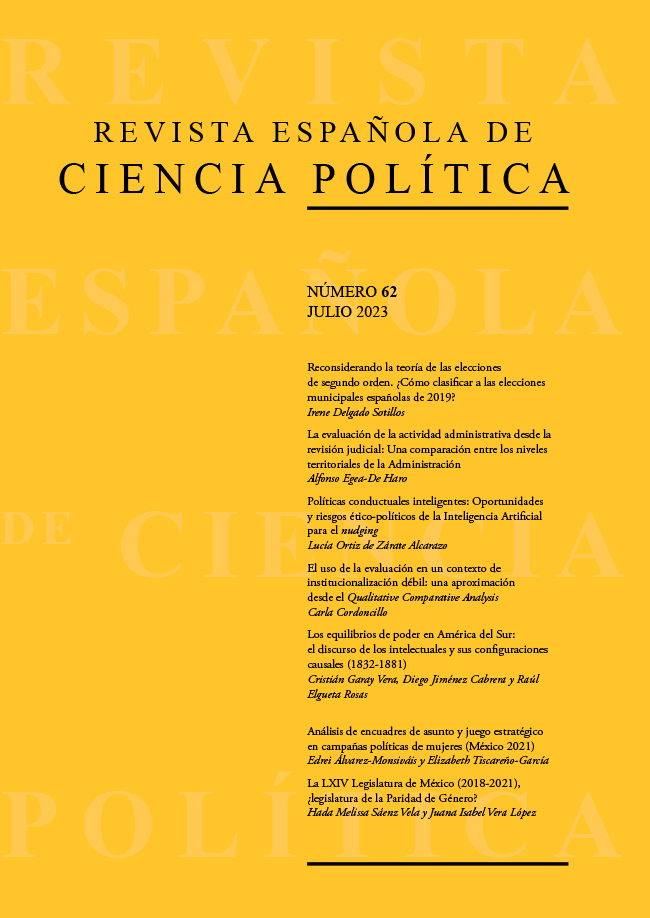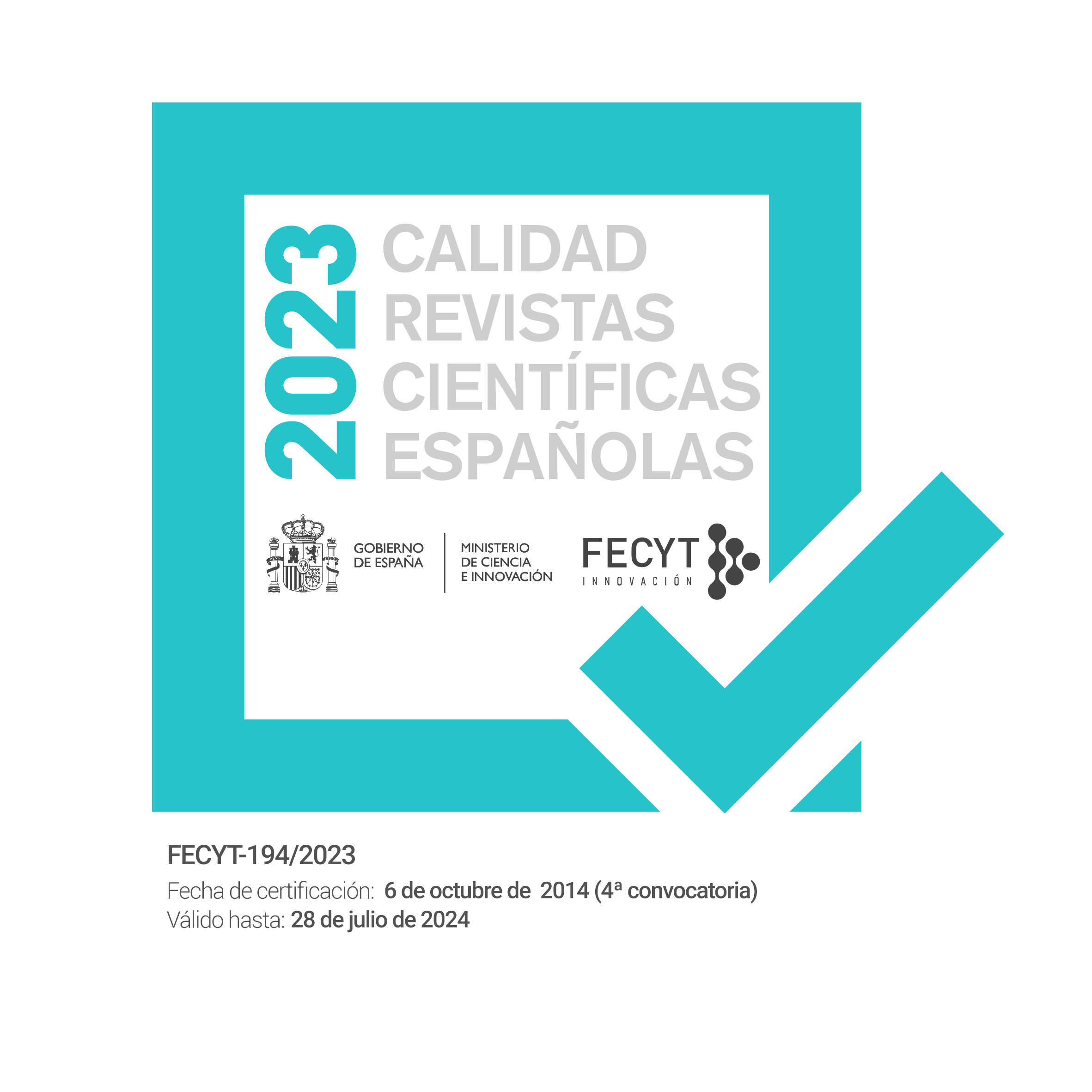Reconsidering the theory of second-order elections. How to classify the 2019 spanish municipal elections?
DOI:
https://doi.org/10.21308/recp.62.01Keywords:
municipal elections, second-order elections, electoral cycle, nationalization, SpainAbstract
This paper analyses the validity of the second-order model in the 2019 municipal elections. We focus, first, on the theoretical evolution that has transformed the model proposed by Reif and Schmitt (1980). Second, it evaluates the explanatory capacity of a model that does not fit with highly fragmented and heterogeneous units of analysis. Finally, a contextual analysis is presented to provide a more robust explanation of the 2019 Spanish municipal election.
Downloads
References
Bechtel, Michael M. 2012. «Not always second order: subnational elections, national-level vote intentions, and volatility spillovers in a multi-level electoral system», Electoral Studies, 31: 170-183. https://doi.org/10.1016/j.electstud.2011.10.005
Binzer, Sara Hobolt y Jill Wittrock. 2011. «The second-order election model revisited: an experimental test of vote choices in European Parliament elections», Electoral Studies, 30: 29-40. https://doi.org/10.1016/j.electstud.2010.09.020
Bürklin, Wilhelm P. 1987. «Why study political cycles?», European Journal of Political Research, 15(2): 131-143. https://doi.org/10.1111/j.1475-6765.1987.tb00868.x
Cabeza, Laura y Matthias Sacntamburlo. 2021. «Dual voting and second-order effects in the quasi-simultaneous 2019 Spanish regional and national elections», Revista Española de Ciencia Política, 55:13-35. https://doi.org/10.21308/recp.55.01
Campbell, James E. 1993. «Surge and decline: the national evidence», en Richard G. Niemi, Herbert F. Weisberg y David C. Kimball (eds.), Controversies in Voting Behavior, Washington: Congressional Quarterly Press.
Capo, Jordi. 1991. «Elecciones municipales, pero no locales», Revista Española de Investigaciones Sociológicas, 56: 143-164.
Carrillo, Ernesto. 1989. «La nacionalización de la política local», Política y Sociedad, 3: 29-46.
Clark, Alistair y Timothy B. Krebs. 2012. «Elections and policy responsiveness», en John, Peter; Mossberger, Karen; Clarke, Susan E. (eds.), The Oxford handbook of urban politics. Oxford University Press.
Delgado, Irene. 1999. «Resultados electorales y orientación del voto en los comicios municipales de 1995», Revista Española de Investigaciones Sociológicas, 86: 247-273.
Delgado, Irene. 2006. «Las elecciones municipales de 2003: entre lo local y lo nacional», en J. Molins y P. Oñate (eds.), Elecciones y comportamiento electoral en la España multinivel. Madrid: Centro de Investigaciones Sociológicas, págs. 195-228.
Delgado, Irene. 2010a. «Between first and second order: what place for the Spanish local elections?», en Carlo Fusaro (ed.) Governi local i regionali in Europea fra sistema elettorali e scelte di voto. Turín: Osservatorio Elettorale, págs. 563-587.
Delgado, Irene. 2010b. «Elecciones municipales en España. Dimensiones analíticas y aspectos distintivos de ocho procesos electorales (1979-2007)», Política y Sociedad, 47(3): 13-36.
Delgado, Irene. 2018. «Las elecciones municipales en España: análisis comparado de diez procesos democráticos», en Benigno Pendás (dir.), España Constitucional (1978-2019). Trayectorias y Perspectivas. Madrid: Centro de Estudios Políticos y Constitucionales.
Delgado, Irene y López Nieto, Lourdes (1992). «Un análisis de las elecciones municipales (Contribución a partir del caso español)», Revista de Estudios Políticos, 76: 195-219.
Denters, Bas; Michael Goldsmith; Andreas Ladner; Poul Erik Mouritzen y Lawrence E. Rose. 2014. Size and local democracy. Cheltenham: Edward Elgar.
Frandsen, Annie G. 2002. «Size and electoral participation in local elections», Environment and Planning C, 20(6): 853-870. https://doi.org/10.1068/c0228
Gendzwill, Adam, Ulrik Kjær y Kristof Steyvers. 2021. «Between vertical integration and horizontal variation: comparing local elections and voting in 41 European countries». ECPR General Conference, Evento virtual, 30 agosto-3 septiembre.
Golder, Sona N.; Ignacio Lago; André Blais; Elisabeth Gidengil y Thomas Gschwend. 2017. Multi-level electoral politics: beyond the second-order election model. Oxford: Oxford University Press.
Heath, Anthony; Ian McLean; Bridget Taylor y John Curtice. 1999. «Between first and second order: a comparison of voting behaviour in European and local elections in Britain», European Journal of Political Research, 35(3): 389-414. https://doi.org/10.1111/1475-6765.00454
Henderson, Ailsa y McEwen, Nicola. 2010. «A comparative analysis of voter turnout in regional elections», Electoral Studies, 29(3): 405-416. https://doi.org/10.1016/j.electstud.2010.03.012
Hix, Simon y Michael Marsh. 2007. «Punishment or protest? Understanding European Parliament elections», The Journal of Politics, 69: 495-510. https://doi.org/10.1111/j.1468-2508.2007.00546.x
Johnston, Ron y Charles Pattie. 2006. Putting voters in their place: geography and elections in Great Britain. Oxford: Oxford University Press
Justel, Manuel. 1995. La abstención electoral en España. Madrid: Centro de Investigaciones Sociológicas.
Kjaer, Ulrijk y Kristof Steyvers. 2019. «Second thoughts on second-order? Towards a second-tier model of local government elections and voting», en Richard Kerley, Joyce Liddle y Pamela Dunning (eds.), The Routledge Handbook of international local government. Londres: Routledge.
Koepke, Jason R. y Nils Ringe. 2006. «The second-order election model in an enlarged Europe», European Union Politics, 7(3): 321-346. https://doi.org/10.1177/1465
Lefevere, Jonas y Peter Van Aelst. 2014. «First-order, second-order or third-rate? A comparison of turnout in European, local and national elections in the Netherlands», Electoral Studies, 35: 159-170. https://doi.org/10.1016/j.electstud.2014.06.005
Marsh, Michael. 1998. «Testing the second-order election model after four European elections», British Journal of Political Science, 28: 591-607. https://doi.org/10.1017/S000712349800026X
Marsh, Michael. 2002. «Electoral context», en Mark N. Franklin y Christopher Wlezien,(eds.). The Future of Elections Studies. Oxford: Pergamon.
Miller, William L. 1988. Irrelevant elections? The quality of local democracy in Britain. Oxford: Oxford University Press.
Mughan, Anthony. 2014. «Towards a political explanation of government vote losses in midterm by-elections», American Political Science Review, 80: 761-775. https://doi.org/10.2307/1960537
Niemi, Richard G. y Herbert F. Weisberg. 1993. Classics in voting behavior. Washington, DC: CQ Press.
Norris, Pippa. 1995. British by-elections. Oxford: Clarendon Press.
Oppenhuis, Erik, Cees van der Eijk y Mark Franklin. 1996. «The party context: outcomes», en Cees van der Eijk y Mark Franklin (eds.), Choosing Europe? The European electorate and national politics in the face of Union. Ann Arbor: University of Michigan Press.
Rallings, Colin y Michael Thrasher. 1993. «Exploring uniformity and variability in local electoral outcomes: some evidence from English local elections, 1985-1990», Electoral Studies, 12: 366-384. https://doi.org/10.1016/0261-3794(93)
-M
Rallings, Colin y Michael Thrasher. 1999. «Local votes, national forecast-using local government by-elections in Britain to estimate party support», International Journal of Forecasting, 14: 153-162.
Reif, Karlheinz. 1984. «National election cycles and European elections, 1979 and 1984». Electoral Studies, 3(3): 244-255. https://doi.org/10.1016/0261-3794(84)90005-2
Reif, Karlheinz. 1997. «Reflections: European elections as member state second-order elections revisited», European Journal of Political Research, 31: 115-124.
Reif, Karlheinz y Hermann Schmitt. 1980. «Nine second-order national elections. A conceptual framework for the analysis of European election results», European Journal of Political Research, 8: 3-44. https://doi.org/10.1111/j.1475-6765.1980.tb00737.x
Schmitt, Herman; Alberto Sanz; Daniela Braun y Eftichia Tegeroglou. 2020. «It all happens at once: understanding electoral behaviour in second-order elections», Politics and Governance 8(1): 6-18. https://doi.org/10.17645/pag.v8i1.2513
Schakel, Arjan H. 2015. «How to analyze second-order election effects? A refined second-order election model», Comparative European Politics, 13(6):636-655.
Schakel, Arjan y Régis Dandoy. 2014. «Electoral cycles and turnout in multilevel electoral systems», West European Politics, 37(3): 605-623. https://doi.org/10.1080/01402382.2014.895526
Stimson, James A. 1976. «Public support for American presidents: a cyclical model», Public Opinion Quarterly, 40: 1-21. http://www.jstor.org/stable/2748443
Thomsen, Søren. 2007. «Impact of national politics on local elections in Scandinavia», Scandinavian Political Studies, 21(4): 325-345. https://doi.org/10.1111/j.1467-
1998.tb00018.x
Trujillo, José M.; Carmen Ortega y Juan Montabes. 2015. «Tipo de hábitat y comportamiento electoral: los efectos contextuales sobre la abstención diferencial en Andalucía (2011-2012)», Revista Española de Ciencia Política, 37: 31-61. https://recyt.fecyt.es/index.php/recp/article/view/37648
Tufte, Edward R. 1975. «Determinants of the outcomes of midterm congressional elections», American Political Science Review, 69: 812-826.
Vallés, Josep M. y Sánchez, Jordi (1994). «Las elecciones municipales en España entre 1979 y 1991: balance provisional», en P. del Castillo (ed.), Comportamiento político y electoral, Madrid: CIS, pp. 365-384.
Van Houwelingen, Pepijn. 2017. «Political participation and municipal population size: a meta-study», Local Government Studies, 43(3): 408-428. https://doi.org/10.1080/03003930.2017.1300147
Downloads
Published
How to Cite
Issue
Section
License
Copyright (c) 2023 Irene Delgado Sotillos

This work is licensed under a Creative Commons Attribution-NonCommercial-NoDerivatives 4.0 International License.






